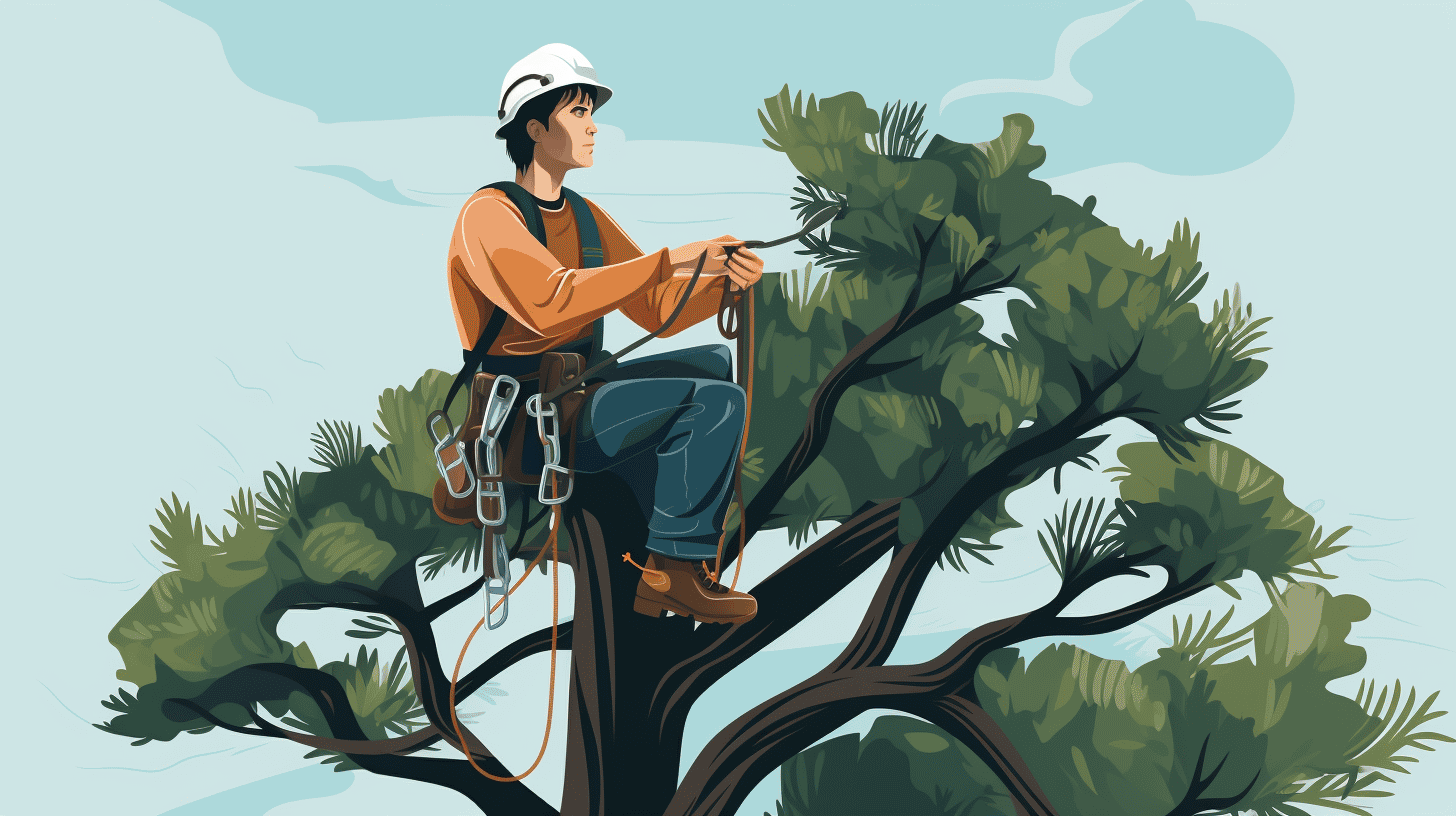The world in 2024 is greener and more adventurous, with a growing band of arborists taking the lead in outdoor activities. They're not just confined to their conventional roles of planting, nurturing, and maintaining trees; modern arborists are laying down roots in all kinds of fascinating pursuits. Welcome to a world where outdoor hobbies, sustainable tree care practices, and innovative landscaping designs are more than just buzzwords - they are profound trends revolutionizing the traditional conception of arboriculture. This article highlights these emerging trends, shaping the way we interact and coexist with nature in our own backyards and shared outdoor spaces.
Ready to embark on this eye-opening journey? Grab your boots and let’s dive into the botanical world of 2024. There's a lot to unpack, from the sustainable practices breaching the mainstream to the luxury upgrades that are turning backyards into outdoor retreats. In the evolving landscape of arboriculture, one thing is clear: the future is looking extraordinary – and extraordinarily green! With a mix of stewardship, technology, community participation, and a dash of luxury, the trends of arboriculture, in 2024, are charting a sustainable, recreational, and aesthetically pleasing path.
Defining Trends in Arboriculture 2024
As we venture deeper into the 21st century, we can't help but notice the emerging trends in every field, not least of all in arboriculture. This remarkable blend of science and art, dedicated to planting, caring for, and maintaining individual trees, is continuously evolving. Several critical trends are forecasted to shape the arboriculture landscape in 2024.
Environmentalism
A significant trend anticipated within the arboriculture sector is a heightened emphasis on environmentalism. As the world grapples with the impacts of climate change, arboriculturists are expected to shift focus towards more sustainable and environmentally-friendly approaches. These practices may include the use of organic fertilizers for enhanced soil health, improved, water-efficient irrigation systems, and selecting tree species most adept to surviving in localized climates.
Indeed, the practice of arboriculture won't only be about maintaining the health and beauty of trees but also about leveraging them as tools for environmental preservation. Trees have long been known for their ability to absorb harmful pollutants and carbon dioxide; hence, they are nature's most efficient, cost-effective carbon capture technology. As such, tree planting campaigns - previously considered only an aesthetic or recreational pursuit - will now bear more significant implications for environmental health and conservation.
Digitalization
Another trend not to be overlooked is the digitalization of arboriculture. Technological advancements have nudged all sectors towards a digital revolution, and arboriculture is no exception. Software solutions for tree inventory management, drone technology for aerial tree inspections, and advanced data analysis to predict tree growth patterns and health are expected to be commonplace by 2024.
In a digital world brimming with boundless innovation, embracing technology will be crucial for arboriculturists who wish to enhance their efficiency, precision, and success rates. While the sight of cutting-edge drones hovering over old-growth trees may appear incongruous today, by 2024, we could very well find it to be the new normal!
Community Engagement
Last but certainly not least, community engagement is predicted to be a defining trend of arboriculture in 2024. We all know that trees enhance the quality of life in cities and towns, providing not just beauty, shade, and habitat for wildlife, but also a sense of connection and community. That’s why there’s growing emphasis on engaging local communities in tree planting and maintenance initiatives.
After all, it's not just about planting trees; it's about planting seeds of awareness and appreciation, too. By encouraging community participation in local arboriculture initiatives, we foster a sense of shared responsibility for our urban forests. This encourages people to care more deeply about the trees in their local parks, by their office, and in their own backyards.
Bearing these trends in mind, it's clear that our perception and practice of arboriculture will likely metamorphose come 2024. These shifts, pivoting around sustainability, technology, and community engagement, illustrate the gradual evolution of this dynamic field. Extraordinarily, it's not only arboricultural practices that are set to change; our relationship with trees and the broader natural world is set for transformation too. As the saying goes: in nature, nothing is constant except change. In the world of arboriculture, that couldn't be more accurate.
Do remember that "nature, wellness, and the rediscovery of play" will be the defining trends of arboriculture in 2024. Who knew that caring for trees could have such profound and positive effects on our world?
Sustainable Tree Care Practices
With the increasing focus on environmental sustainability, it's crucial to consider eco-friendly practices in all aspects of our lives, including tree care. Sustainable tree care involves the use of strategies that do not harm the environment while effectively maintaining and nurturing trees. This approach not only enhances the longevity and health of trees but also contributes to the well-being of the local ecosystem and biodiversity.
To ensure that you are practicing sustainable tree care, it's essential to incorporate the following elements results in a win for both the tree and the environment:
- Using Native and Local Plant Varieties: By incorporating native and local plant varieties into your tree care routine, you assist in the preservation and promotion of the local ecosystem. These plants are inherently adapted to the local conditions, so they require fewer resources like water, fertilizers, and pesticides to thrive. This reduces their environmental impact and promotes biodiversity, as they provide a natural habitat for local wildlife.
- Organic Maintenance Practices: Using organic tree care methods can significantly minimize harm to the environment. This involves using natural fertilizers and avoiding harmful pesticides, thus preserving the local soil health and preventing contamination of water sources.
- Correct Pruning Techniques: Proper pruning preserves the tree’s health and maintains its natural form. Over-pruning not only harms the tree but puts stress on it, making it less resilient to pests, disease, or harsh weather conditions.
- Recycling Tree Waste: All the waste derived from your tree care practices should be recycled back into the environment. For instance, wood chips can be used to mulch around your trees and plants, forming a protective barrier that conserves water and suppresses weeds.
An emphasis on sustainable practices in tree care takes us one step closer to preserving and enhancing the health of our environment. And, indeed, the use of native and local plant varieties stands out as an important practice. By adopting these measures, we not only ensure the growth and longevity of our trees, but also make a valuable contribution to local ecosystems and biodiversity. So, let’s embrace sustainability in all aspects of tree care and enjoy the enduring rewards it brings.
Innovative Landscaping Designs
Welcome to the world of innovative landscaping designs, where nature's beauty meets human ingenuity. This article explores cutting-edge trends that are transforming outdoor spaces into awe-inspiring havens for relaxation and entertainment. These trends reveal how homeowners are breathing new life into their exteriors by maximizing space, introducing outdoor kitchens, incorporating water features and fireplaces, and leveraging smart technology.
Maximizing Outdoor Space
The trend of maximizing outdoor space brings an exciting shift in landscaping. It's about more than just having a nice garden; it provides homeowners with a way of making the most of every square inch available. This innovative design strategy might see you converting an underused side yard into a cozy dining area or transforming a small patch of grass into a vibrant flower bed. The options are endless and creativity rules the realm. Some popular ways to maximize your outdoor space include:
- Creating multi-functional spaces
- Combining indoor and outdoor living areas
- Using vertical spaces with trellises and vertical gardens
- Growing edible gardens in small spaces
Outdoor Kitchens
Outdoor cooking and dining are not just summer activities anymore. With the introduction of outdoor kitchens in landscaping designs, your backyard can be an extension of your living space year-round. These kitchens are fully functional, complete with a grill, counter space, refrigerator, and sometimes even a pizza oven. From preparing breakfast on sunny mornings to hosting vibrant evening barbecues, outdoor kitchens present an opportunity for gastronomy with a difference.
Water Features
The soothing sound of flowing water can add a sense of tranquility to your backyard. Water features, such as fountains, waterfalls, and pond designs, are gaining popularity in landscaping. They can be customized to suit your taste and the space available. Whether you want a Koi pond to bring life and color to your garden or a cascading waterfall as a standout feature, a water body can revitalize your outdoor space beautifully.
Fireplaces
Nothing quite captures the magic of outdoor living like cozy gatherings around a crackling fire. Outdoor fireplaces are a trending feature in landscaping designs. From traditional stone fireplaces to modern fire pits, these elements can create a warm and social atmosphere during those festive times or chillier nights.
Smart Technology
Moving on to an exciting development in landscaping, we have the integration of smart technology. Indeed, our data reveals that outdoor living trends for 2024 include technology taking center stage in landscaping designs. By leveraging automated systems, you can control your outdoor lighting, irrigation, and even pool temperature with just a swipe on your smartphone. Besides providing convenience, this innovative approach promotes sustainability by facilitating controlled usage and minimizing wastage.
In the end, landscaping is about creating a space that reflects your persona. These innovative designs and features can help you achieve a backyard that’s not only aesthetically pleasing but also functional and sustainable.
Sustainable Landscaping Practices
Over the past few years, a new trend has emerged in the space of garden and property maintenance, and that is sustainable landscaping. More and more homeowners are recognizing the importance of sustainable practices, not only as a means of enhancing their home's aesthetic appeal but also as a method of contributing to environmental conservation. Sustainable landscaping, as a term, represents practices that are both eco-friendly and maintainable over the long-run. In particular, the use of low-maintenance plants and the introduction of eco-lawns have become increasingly popular.
Low-Maintenance Plants
Homeowners are often ungainly with the constant demand of high-maintenance plants; hence, the switch to low-maintenance options. These plants require fewer resources such as water, fertilizers, and consistent care, making them an excellent choice for sustainability.
Here are some reasons to consider low-maintenance plants:
- Water conservation: These plants typically require less water than their higher maintenance counterparts. This results in notable water savings over time.
- Reduced chemical use: Low-maintenance plants generally require fewer chemicals like fertilizers or pesticides, once again contributing to environmental conservation.
- Time and energy efficient: With fewer needs, these plants also save homeowners time and energy, which they can direct to more pressing needs or to simply relax and enjoy their outdoor space.
Eco-Lawns
Eco-lawns, also known as ecological lawns, provide another avenue for sustainable landscaping. These lawns consist of a range of plant species, including grasses and flowering plants. Like low-maintenance plants, eco-lawns confer several benefits:
- Biodiversity: Eco-lawns are rich in plant species, enhancing local biodiversity, which is beneficial to various ecosystems.
- Low water usage: These lawns can survive with minimal water, making them perfect for regions with water restrictions.
- Less mowing: Eco-lawns rarely need mowing, offering a real time-saver for busy homeowners.
Indeed, sustainable landscaping practices such as the use of low-maintenance plants and the cultivation of eco-lawns represent an excellent balance between aesthetics and environmental consciousness. It's an exciting and reinforcing phenomena that lends credence to the phrase "beauty is not skin deep". Not only do these practices beautify our immediate surroundings, they also reach deeper, contributing to the wellness of the planet. As we move forward, these practices appear set to further gain foothold among homeowners far and wide.
Arboriculture Innovations in 2024
The world of arboriculture is stepping into the future with unprecedented innovations set to roll out in 2024. With pressing environmental concerns like water scarcity and soil degradation, the field has turned its focus on two pivotal areas: water resources management and improving soil health. Let's delve deeper into what's in store for arboriculture in 2024.
Water Resources Management
Water, the very essence of life, is a precious resource that is fast decreasing globally. With this in mind, arboriculture is placing a high priority on efficient water resources management. New methodologies and technologies aim to minimize wastage and recycle wherever possible.
- Smart Irrigation Systems: These automation devices are set to become a game-changer, allowing for precise water distribution based on the individual needs of different tree species. It's an intelligent way of conserving water while still catering to the trees' needs.
- Drought-resistant Tree Species: Another strategic move is the development of genetically modified tree species. These resilient trees can survive with minimal water, making them a valuable asset in regions prone to water scarcity.
- Moisture Monitoring Technology: Moisture sensors provide real-time data regarding the moisture levels of the soil. This information can help in determining the right time and volume of irrigation, thus improving water efficiency.
Soil Health
Rooted in the soil, trees' growth and health are fundamentally linked to the quality of the soil they grow in. Enhanced soil health methodologies are rapidly gaining momentum in arboriculture and are expected to reach new heights in 2024.
- Biochar: This carbon-rich compound enhances the soil’s fertility and water-holding capacity.
- Organic Mulches: An all-natural solution that enhances soil structure, suppresses weeds, and increases soil fertility.
- Soil Testing: Advanced soil testing methods can provide a detailed nutritional profile of the soil. This data can be used to address nutrient deficiencies and create custom fertilization regimes for various tree species.
Looking at these promising innovations, one can say with confidence that the year 2024 is set to be a landmark year for arboriculture. Through smart water resources management and a focus on soil health, the industry aims to solve two of the most pressing environmental challenges of our time, leading to more sustainable and healthier forests in the future. The shift towards these two areas of focus is a testament to the industry's commitment to working in harmony with nature, showing that the future of arboriculture is not only forward-thinking but also environmentally friendly.
Luxury Upgrades in Arboriculture
As the appreciation for outdoor spaces soars, Arboriculture—the art and science of nurturing and taming trees—is increasingly gaining new dimensions. Homeowners are growing more intent on transforming their backyards into luxurious outdoor retreats, with the need for remarkable and stylish additions at an all-time high.
Outdoor Seating
One major trend that is swiftly sweeping across the field of Arboriculture is the integration of outdoor seating areas into design plans. An afternoon under the cool shade of a tall tree or an evening lounging in a beautifully lit garden is now a widely cherished luxury. These spaces provide a perfect blend of nature's tranquility and human comfort, all in the confines of your private property.
Luxury upgrades to outdoor settings often feature comfortable yet sophisticated seating spaces, such as:
- Patio Sets: Comprising outdoor tables and chairs, often designed to withstand various weather conditions. Patio sets serve as an excellent spot for outdoor dining, working or enjoying your favorite novel.
- Hammock Chairs: Often slung between two sturdy trees, these offer an ideal spot for leisure and meditation. The gentle swaying motion of hammock chairs brings an additional layer of relaxation.
- Garden Benches: Blend seamlessly with nature, fostering a rustic charm while providing functional seating spaces.
Made with high-quality materials, these seating options are available in various designs and styles, contributing to the luxury aesthetic. The beauty of incorporating such a trend is that it's adaptable; you can align the overall ambiance with your personal preference, creating a one-of-a-kind outdoor oasis.
Where the trends are casual and carefree, the impact they have on your garden's aesthetic is anything but. So next time you're looking to upgrade your outdoor space, don't overlook the seamless integration of these popular treelands beauty adds to your overall luxurious enhancement.
Remember, Arboriculture isn't just about taking care of trees—it's also about how these trees can enhance and transform your lifestyle, providing a sanctuary of luxury right in your own backyard. The proper selection and arrangement of outdoor seating can indeed redefine your experience of luxury and tranquility. Let the soul of Arboriculture sweep you off your feet and into the embrace of nature’s lap.
Outdoor Leisure Market Trends
Imagine this: You're basking in the sun, breathing in the fresh air, surrounded by Mother Nature's splendid glory. It's a scene of perfect outdoor leisure, isn't it? The good news is, more and more people are realizing the enormous benefits of such activities, leading to a surge in the Outdoor Leisure Market. Now, if you're wondering what exactly this market entails, allow us to shed light on this exciting industry.
Outdoor leisure activities are the ones we engage in outside our living premises, primarily for recreation, entertainment, and physical wellness. Camping, gardening, fishing, hiking, and BBQs are some popular examples. Now that we know what it encompasses, let's move on to some relevant market trends.
- Rising Awareness Towards Physical Fitness: Outdoor recreational activities often involve physical movement, making them a fun yet effective way of staying in shape. Which other setting allows you to burn calories while also enjoying the beauty of a sunset or the aroma of flowers in full bloom?
- Growing Preface for Nature-Based Activities: Think hiking, bird watching, or wilderness camping. People yearn for such immersive experiences, fleeing from the monotony of their digitized lives. And many are willing to spend a pretty penny to achieve this peace and tranquility.
- Increasing Disposable Income: With higher disposable incomes, individuals are ready to invest more in their leisure and recreational pursuits. Whether it's buying camping gear, setting up a patio garden, or going on an adventure trip, the potential consumer base is expanding.
In addition to these trends, there's a prediction we ought to underline here: According to market experts, the Global Outdoor Leisure Market is expected to rise considerably between 2024 and 2032. One glance at the factors discussed above, and this hardly comes as a surprise.
As the outdoor leisure market soars, so do the opportunities for businesses – both existing and new. Be it service providers, product manufacturers, or startups dabbling in outdoor tech gadgets, the sky is the limit. However, with opportunity comes responsibility. Complementing the joy of outdoor leisure with sustainable practices can ensure we preserve our precious environment for future generations to enjoy.
Shifting societal norms, expanding economy, and a renewed love for nature are all thrusting the Outdoor Leisure Market into an exciting era. So get ready, because there's no cap on how high this market can rise.
Growing Significance of Outdoor Hobbies
In our fast-paced, technologically-driven world, it can sometimes feel as though we're losing connection with nature. However, the rapidly growing trend of outdoor hobbies signals that many of us crave a return to our roots. There's something appealing about gazing upon expansive fields, feeling the cold wind breeze through our hair, or listening to the soft rustle of leaves underfoot. The surge in popularity of outdoor hobbies signifies a collective yearning to tap into these simple joys that nature provides, with additional benefits.
Outdoor hobbies, which encompass a wide array of activities ranging from hiking and camping to bird watching and gardening, offer more than just an escape from the urban jungle. They fulfill our inherent need to be outdoors, stretch our legs, and breathe in the fresh air. They're a window into the natural world, a way to learn, grow, and discover the earth, its creatures, and its landscape.
Three main rewards of outdoor hobbies include:
Physical Benefits:
Engaging in outdoor activities helps in burning calories, building muscles, improving coordination and balance, and promoting healthier lifestyles. They are instrumental in promoting physical fitness, improving cardiovascular health, and aiding weight control.
Mental Benefits:
The great outdoors can function as a natural stress-reliever. Research indicates that exposure to nature can boost mood, reduce anxiety, and promote relaxation.
Social Benefits:
Outdoor hobbies often provide opportunities for social interaction, fostering relationships, and creating long-lasting bonds.
So whether these hobbies involve an adrenaline-fueled climb up a mountain, a serene stroll along a forest trail, or the quiet contemplation of a fishing line, they are all connected by the common thread of cherishing and exploring the natural world.
Outdoor recreation activities are thus among the fastest-growing trends, driving millions towards healthier, more satisfied lives brimming with unforgettable experiences and connections.
Allocate some time each week to your favourite outdoor hobby and experience the transformation yourself. Engage with others, challenge yourself, and witness the beauty of nature. You'll come to understand, firsthand, the significance of outdoor hobbies and the irreplaceable value they bring to our lives.
Understanding and engaging with nature is a timeless pursuit, and the surge in interest in outdoor hobbies is testament to its enduring relevance. So step outside, explore, and reconnect with the earth. After all, it's your world too!
Conclusion
As we move further into 2024, it's clear that the world of arboristry and outdoor leisure activities is evolving, with a powerful emphasis on sustainability, technology, and community engagement. The way we interact with our outdoor spaces is changing, and with these changes come exciting new possibilities for both professionals and hobbyists.
Whether it's devising sustainable tree care practices or incorporating smart technology into landscaping designs, these fresh developments in arboriculture and outdoor hobbies are shaping a brighter future for our environment.
Naturally, these changes also demand robust, top-tier gear for those who work and recreate outdoors. No matter the weather or the task, protection and comfort are paramount. At Rain Gear Pro, we understand these demands and raise the bar for what work gear can be. Our chainsaw safety pants expertly blends protection and comfort, crafted with precision to withstand the toughest challenges an arborist or outdoor enthusiast might face.
With a shift in the arboriculture scene and a growing significance of outdoor leisure activities, let's march forward—equipped and prepared to engage with our outdoor spaces in impactful, environmentally conscious ways. And remember, no matter where these innovative trends lead us, Rain Gear Pro is there to keep you protected, so you can focus on what matters most: making the most out of the great outdoors.
Frequently Asked Questions
-
What are some popular outdoor activities among Arborists in 2024?
Some popular outdoor activities among Arborists in 2024 include tree climbing competitions, aerial rescue training, tree planting initiatives, chainsaw carving, and sustainable forest management workshops.
-
Why are tree climbing competitions popular among Arborists?
Tree climbing competitions are popular among Arborists as they allow them to showcase their skills, agility, and climbing techniques. These competitions provide opportunities for Arborists to network, learn from each other, and stay updated with the latest industry practices.
-
What is aerial rescue training and why is it important for Arborists?
Aerial rescue training is a crucial activity for Arborists as it prepares them to rescue fellow climbers or workers who may be injured or stuck in trees. It involves learning safe and efficient techniques to perform rescues at height, ensuring the well-being of both Arborists and tree workers.
-
What are the benefits of participating in tree planting initiatives for Arborists?
Participating in tree planting initiatives allows Arborists to contribute to environmental conservation, promote tree diversity, and enhance green spaces. It also helps Arborists develop a deeper understanding of tree species, soil conditions, and planting techniques.
-
What is chainsaw carving and why do Arborists enjoy it?
Chainsaw carving is a unique form of art where Arborists use chainsaws to transform tree trunks into intricate sculptures. Arborists enjoy chainsaw carving as it allows them to showcase their creativity, merge their passion for trees and art, and create beautiful pieces from natural materials.





















Leave a comment
This site is protected by hCaptcha and the hCaptcha Privacy Policy and Terms of Service apply.